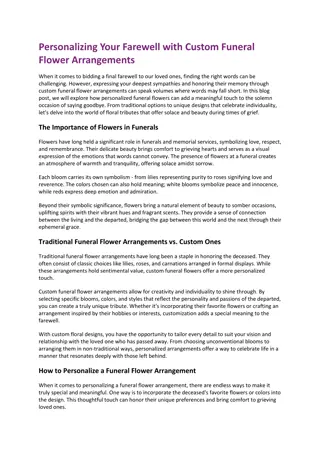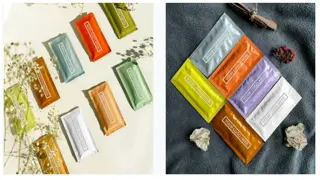OOLAB Custom Orthotics Top Cover Materials Overview
Explore the various top cover materials available for OOLAB custom orthotics, including Vinyl, Ultrahyde, Cloth, Microcell, and Suede. Each material offers unique features and benefits for different types of footwear, from dress shoes to athletic wear. Discover the characteristics of each material to choose the most suitable option for your orthotic needs.
Download Presentation

Please find below an Image/Link to download the presentation.
The content on the website is provided AS IS for your information and personal use only. It may not be sold, licensed, or shared on other websites without obtaining consent from the author.If you encounter any issues during the download, it is possible that the publisher has removed the file from their server.
You are allowed to download the files provided on this website for personal or commercial use, subject to the condition that they are used lawfully. All files are the property of their respective owners.
The content on the website is provided AS IS for your information and personal use only. It may not be sold, licensed, or shared on other websites without obtaining consent from the author.
E N D
Presentation Transcript
OOLAB CUSTOM ORTHOTICS oolab.com
TOP COVER MATERIALS Black/Blue ETC Vinyl Only, 1/16th & 1/8th Ultrahyde Only, 1/16th & 1/8th 1/8th Black Microcell, Pink/Purple & Blue/Green 1/16th Black Ultrasuede Diabetic (Poron with Plastazote) (Premium) 1/8th Neoprene X-Static (Premium) Brown Sandal Suede (Naot Suede) Tan Sandal Suede Perforated 1/16th Leather (Premium) 1/8th Spenco Black (Premium) *All top covers have Full- length, Sulcus or length as an option oolab.com
VINYL Highly durable vinyl laminated to underlying soft cushion material* Available in 1/16 and 1/8 thickness as well as Vinyl Only (no poron cushioning) Key Features: Non absorbent Highly durable Easy to clean Minimal Friction * Vinyl topcovers can be requested to have black nyplex instead of blue poron for cushioning Suitable for: Dress Shoes, Casual Walkers, Casual Shoes oolab.com
ULTRAHYDE Soft covering, laminated to 1/16 or 1/8 cushioning* underlay Also available without cushioned underlay (Ultrahyde Only) Popular choice of material as it is easy to clean, durable and will not absorb moisture * Ultrahyde topcovers can be requested to have black nyplex instead of blue poron for cushioning oolab.com
1/8TH ETC Uniform cloth type covering which provides anti-friction and reduces shearing forces while providing moisture wicking capabilities Key Features: Does not absorb moisture Tear resistant Non-slip *Blue/Black ETC is the DEFAULT top cover if not specified on the Rx and will be selected based on shoe choice or gender Available in 1/8 thickness -- Blue or Black Good choice for: Walking, Running & Athletics oolab.com
MICROCELL Closed cell EVA product Choice of: Black Green/Blue Purple/Pink Available in 1/8 thickness only Good option for deep heel cups Key Features: Shock absorbing uniform material Easy to clean Non-absorbent covering Lightweight oolab.com
1/16TH BLACK SUEDE (ULTRASUEDE) 1/16" thickness Suede feel to top surface with black foam, quick recovery foam underlay Black colour Suitable for: footwear in which there are limitations in space (i.e.: Dress Shoes) oolab.com
DIABETIC/ARTHTRITIC (PREMIUM) Available thickness of 1/8 Plastazote + 1/16 Poron Key Features: Shock absorbing uniform material Easy to clean Non-absorbant Evenly dissipate shear forces acting on plantar surface of foot (reduces and eliminates friction) oolab.com
1/8TH NEOPRENE 1/8" thickness Black colour Key Features: Shock absorbing Cushioning material surface oolab.com
X-STATIC (PREMIUM) 1/8th in thickness Made with pure silver, which means there are no chemicals or fear of toxicity to the consumer Key Features: Durable Eliminates Odor Regulates temperature oolab.com
SPENCO (PREMIUM) Only offered as a 1/8th thickness option Closed cell nitrogen injected material absorbs shock and provides maximum comfort Ideal for individuals wanting durability combined with heel-to- toe cushioning and comfort Key Features 4-way stretch fabric helps reduce friction and heat Helps prevent blisters from forming oolab.com
PERFORATED LEATHER (PREMIUM) Perforated material to allow for moisture control Ideal for individuals with sweaty feet Great option for individuals who may be allergic to synthetic materials Key Features: Long lasting Thin Tear resistant Minimal Friction oolab.com
1MM BLACK PUFF Along with our standard underlay option, 1mm Black Puff may be selected as a top cover Minimal cushioning Good option for limitations in space oolab.com
SANDAL TOPCOVERS CHOICE OF: *Choice of top cover WILL be defaulted to selected shoe unless otherwise specified Brown Suede (Naot Suede) Tan Suede *Available in 1/16 suede or suede only option per colour Black Suede (ultrasuede) oolab.com
UNDERLAY MATERIALS *Additional cushioning may be requested typically 1mm or extra 1/16th as Nyplex Vinyl 1mm Black Puff *Underlay can be full length or forefoot only Grey Suede *If a heel hole is requested with no underlay, they will receive a circular rubber skid plate Durasole oolab.com
SHELL MODIFICATIONS oolab.com
HEEL CUP HEIGHT Lab Standards: Flat < 12mm Shallow Typically associated with dress orthotics & footwear 12-14mm Standard Most common 16-18mm Deep oolab.com
1ST RAY CUTOUT Used to increase plantar flexion of the first met shaft Medial cut out of the orthosis Indications: Sesamoiditis Plantarflexed 1st ray 1st met head pain Hallux Valgus (Bunions) oolab.com
1ST MET CUTOUT <45 cutout of medial/distal end of shell Indications: Hallux Valgus (Bunions) 1st met head pain oolab.com
HEEL HOLE Standard 1 and 1.25 hole centrally located in heel cup filled with poron plug Indications: Heel spurs Apply extra relief Localized Plantar Fasciitis pain oolab.com
MEDIAL/LATERAL FLANGES (SHELLVS SOFT) A medial flange (shell) is an extension of the arch of the shell which projects upward with the apex at the area of the navicular tuberosity The purpose of the flange is to provide a more direct force at the medial-plantar aspect of the foot in order to offer more control For some patients, fitting a device with a flange in their shoes can become a problem due to the added bulk of the device in which case a soft flange may be applicable (made out of topcover material) oolab.com
GAIT PLATES These are for adducted or abducted gait patterns in very young children as well as in adults if necessary Gait plates limit in-toeing or out-toeing gait caused by rotational deformities of the lower limb Consist of both medial and lateral flanges and a deep heel cup as well as the gait plate (to induce in-toeing or out-toeing) Two types: In-toe Gait Plate: For out-toeing problems. The medial side extends to the sulcus, tapering to cut out the 4th and 5th mets Out-toe Gait Plate: For in-toeing problems. The lateral side extends to the sulcus, tapering to cut out the 1st and 2nd mets oolab.com
ORTHOTIC ADDITIONS oolab.com
METATARSAL PADS & MET BAR Met. Pad: Tear shaped modification (poron pad) added to the top of the orthotic Default Placements- Standard: End of shell Distal: Moved 6mm distally Function: Offload pressure from the met. Heads to the metatarsal shafts Indications: Metatarsalgia Interdigital Neuroma & Bursitis oolab.com
METATARSAL ACCOM. PADS Standard 1/8th Nyplex pad extending across the 1st met head to the 5th met head distally to sulcus Function: Provide additional cushioning & redistribution of pressure across the met heads Indications: Decreased fat pad Metatarsalgia oolab.com
NEUROMA PADDING Dome shaped pad placed in the metatarsal interspace between the metatarsal heads Typically begins at the proximal third of the metatarsal shafts and ends at the met heads Usually placed between the 2nd-3rd / 3rd-4th interdigital space oolab.com
MORTONS EXTENSION Material (Nyplex, EVA or Rigid) which is added under the first metatarsalphalangeal joint *Rigid requires a polypropylene shell Function: Limit first metatarsalphalangeal R.O.M Indicated for: Dorsiflexed 1st ray Hallux Rigidus/Limitus Short 1st ray oolab.com
REVERSE MORTONS EXTENSION Material (Nyplex or EVA) which is added under the 2nd 5th metatarsal heads Indications: Plantarflexed 1st ray Hallux Valgus (Bunions) oolab.com
HEEL CUSHIONING Standard 1/16th Nyplex cushion pad Indications: Non-centrally located heel spur Loss of fat pad PF pain Rear foot shock absorption oolab.com
HEEL SPUR PADDING Poron horseshoe shaped pad applied around heel cup on top of the orthotic Function: Creates a depression Lifts calcaneus off the orthotic Indications: Heel spur oolab.com
ARCH FILL Padding applied under the arch area of the orthotic plate Increases rigidity of the orthosis by preventing arch collapse Applied to the plantar side of the orthotic Several durometers of fill: Soft Firm Hard oolab.com
ARCH COOKIES (SCAPHOIDPAD) A pad that is plantar and medial to the longitudinal arch and gives extra support and padding to the medial arch area Several different sizes/thickness: i.e.: 1mm, 3mm, 5mm oolab.com
KINETIC WEDGE/DANCERS PAD U shaped cutout underneath the first met head Relieves pressure off of the 1st met head and allows for greater plantarflexion of the 1st met head Indications: Functional Hallux Limitus oolab.com
EXTRINSIC POSTINGS oolab.com
NEUTRAL Firm EVA material added to the plantar side of the orthotic Aids in neutral stabilization of orthotic & calcaneus oolab.com
HEELLIFT Firm EVA post alongside with additional White EVA Adds a lift to one orthotic or bilaterally Maximum height of lift recommended: 10mm (1.0cm) Indications: Leg Length Discrepancy (LLD) Achilles Tendonitis oolab.com
VARUS & VALGUS POSTING Rigid orthotics are routinely posted to accommodate the varus or valgus rearfoot and forefoot dispositions Varus posting helps with a pronated foot or eversion of the calcaneus Valgus posting helps with a supinated foot or inversion of the calcaneus Ultimate goal is to maintain a neutral gait cycle by controlling the hind foot oolab.com
MEDIAL & LATERAL WEDGES Essentially a continuation of a Varus or Valgus post in which extends to the end of the shell Helps aid/control varying degrees of pronation or supination within the hindfoot, midfoot & forefoot oolab.com
MEDIAL & LATERAL FOREFOOT POST Forefoot pronation or supination can be further controlled with a forefoot post Forefoot posting is added on the plantar aspect of the shell to position the orthotic in a varus or valgus direction to effectively distribute ground-reactive forces oolab.com

 undefined
undefined






 undefined
undefined






















